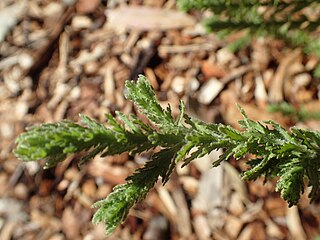
Eremophila subteretifolia, commonly known as Lake King eremophila, is a flowering plant in the figwort family, Scrophulariaceae and is endemic to Western Australia. It is a creeping, prostrate shrub with narrow, sticky, dark green leaves and distinctive orange-red to yellow flowers. It is a rare plant which grows near the edges of salt lakes.
Eremophila anomala, commonly known as Paroo poverty bush, is a plant in the figwort family, Scrophulariaceae and is endemic to two small areas in central Western Australia. It occurs with other species of Eremophila growing in clay loam on basalt outcrops near Paroo.
Eremophila appressa, commonly known as wispy poverty bush, is a plant in the figwort family, Scrophulariaceae and is endemic to two remote locations in the central west of Western Australia. Its most unusual feature is its leaves which, at least when young, are less than 2.5 mm (0.1 in) long and 1 mm (0.04 in) wide and are glued to the stem by resin.

Eremophila citrina is a flowering plant in the figwort family, Scrophulariaceae and is endemic to the centre of Western Australia. It is a dense, rounded shrub with yellow new growth, crowded leaves and lilac-coloured to light purple flowers.
Eremophila clavata is a flowering plant in the figwort family, Scrophulariaceae and is endemic to the south-west of Western Australia. It is a low, dense, spreading shrub with narrow grey, club-shaped leaves and pink to purple, sometimes blue flowers.

Eremophila demissa is a flowering plant in the figwort family, Scrophulariaceae and is endemic to a small area of central Western Australia. It is a low, spreading shrub with small, yellowish grey leaves and branches and mauve to blue flowers.

Eremophila enata is a flowering plant in the figwort family, Scrophulariaceae and is endemic to central areas of Western Australia. It is a low, spreading shrub with serrated leaves and purplish to pinkish flowers.
Eremophila eversa is a flowering plant in the figwort family, Scrophulariaceae and is endemic to a restricted area of Western Australia. It is known from only one plant, now thought to have died. It is a small shrub with small leaves and hairy purple to lilac-coloured flowers.
Eremophila graciliflora, commonly known as slender-flowered eremophila, is a flowering plant in the figwort family, Scrophulariaceae and is endemic to Western Australia. It is a shrub with linear to lance-shaped leaves and red flowers known only from the type specimen collected by Augustus Oldfield and held at the State Botanical Collection at Royal Botanic Gardens in Melbourne, so that a living example has not been recorded for more than 150 years.

Eremophila obovata is a flowering plant in the figwort family, Scrophulariaceae and is endemic to Australia. It is a low, compact shrub with lilac to purple flowers growing mainly in the Northern Territory and Queensland but also Western Australia, South Australia and New South Wales.
Eremophila pallida is a flowering plant in the figwort family, Scrophulariaceae and is endemic to Western Australia. It is a small, spreading shrub with hairy stems, leaves with a few serrations and reddish purple to violet flowers.
Eremophila perglandulosa is a flowering plant in the figwort family, Scrophulariaceae and is endemic to Western Australia. It is a low, spreading shrub which has small leaves with many glandular hairs and mauve or purple flowers.
Eremophila petrophila is a flowering plant in the figwort family, Scrophulariaceae and is endemic to Western Australia. It is a tall, erect, open shrub with rough branches, narrow, sticky leaves and pale lilac-coloured flowers.

Eremophila phyllopoda is a flowering plant in the figwort family, Scrophulariaceae and is endemic to Western Australia. It is an erect or spreading shrub, sometimes round or flat-topped with sticky, hairy leaves and flowers ranging in colour from pink or lilac to purple.
Eremophila pilosa is a flowering plant in the figwort family, Scrophulariaceae and is endemic to Western Australia. It is a small shrub with many tangled branches, with its leaves and branches densely covered with hairs and which has mauve or purple flowers. It occurs in a restricted area in the Pilbara.

Eremophila pinnatifida, commonly known as Dalwallinu eremophila is a flowering plant in the figwort family, Scrophulariaceae and is endemic to Western Australia. It is a spreading, rounded shrub with aromatic, deeply divided leaves and pale purple flowers which are white with purple spots inside. It is a rare plant, known only from a few areas near Perth.
Eremophila revoluta is a flowering plant in the figwort family, Scrophulariaceae and is endemic to Western Australia. It is a low, dense shrub with small, hairy leaves, very hairy sepals and mauve or purple petals.
Eremophila shonae is a flowering plant in the figwort family, Scrophulariaceae and is endemic to Western Australia. It is an erect shrub or a low spreading shrub, depending on subspecies and has very sticky branches and leaves due to the presence of large amounts of resin. The leaves are narrow and the flowers are mauve to purple and white inside with purple spots.
Eremophila undulata, commonly known as wavy-leaved eremophila, is a flowering plant in the figwort family, Scrophulariaceae and is endemic to Western Australia. It is a small shrub with greenish-brown flowers and leaves that have a wavy margin.
Eremophila viscimarginata is a flowering plant in the figwort family, Scrophulariaceae and is endemic to Western Australia. It is a small, erect, prickly shrub with hairy stems, small leaves, greenish-pink sepals and mauve petals.







